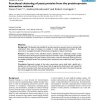258 search results - page 34 / 52 » Predicting protein folding pathways |
BMCBI
2006
13 years 9 months ago
2006
Background: The abundant data available for protein interaction networks have not yet been fully understood. New types of analyses are needed to reveal organizational principles o...
BMCBI
2008
13 years 9 months ago
2008
Background: In the past decades, various protein subcellular-location (SCL) predictors have been developed. Most of these predictors, like TMHMM 2.0, SignalP 3.0, PrediSi and Phob...
BMCBI
2006
13 years 9 months ago
2006
Background: The main processing pathway for MHC class I ligands involves degradation of proteins by the proteasome, followed by transport of products by the transporter associated...
BMCBI
2007
13 years 9 months ago
2007
Background: The problem of protein structure prediction consists of predicting the functional or native structure of a protein given its linear sequence of amino acids. This probl...
BMCBI
2006
13 years 9 months ago
2006
Background: In the area of protein structure prediction, recently a lot of effort has gone into the development of Model Quality Assessment Programs (MQAPs). MQAPs distinguish hig...


